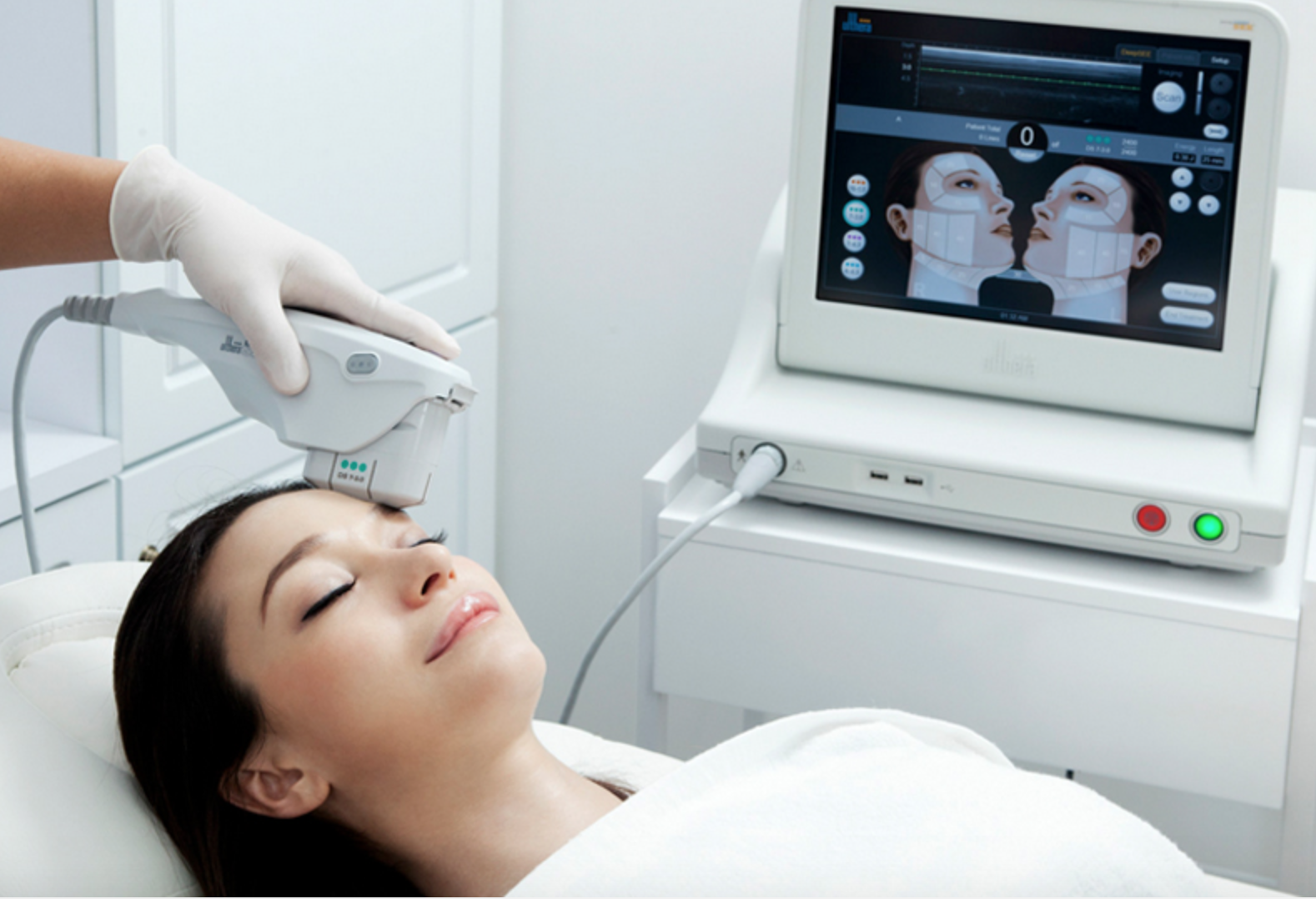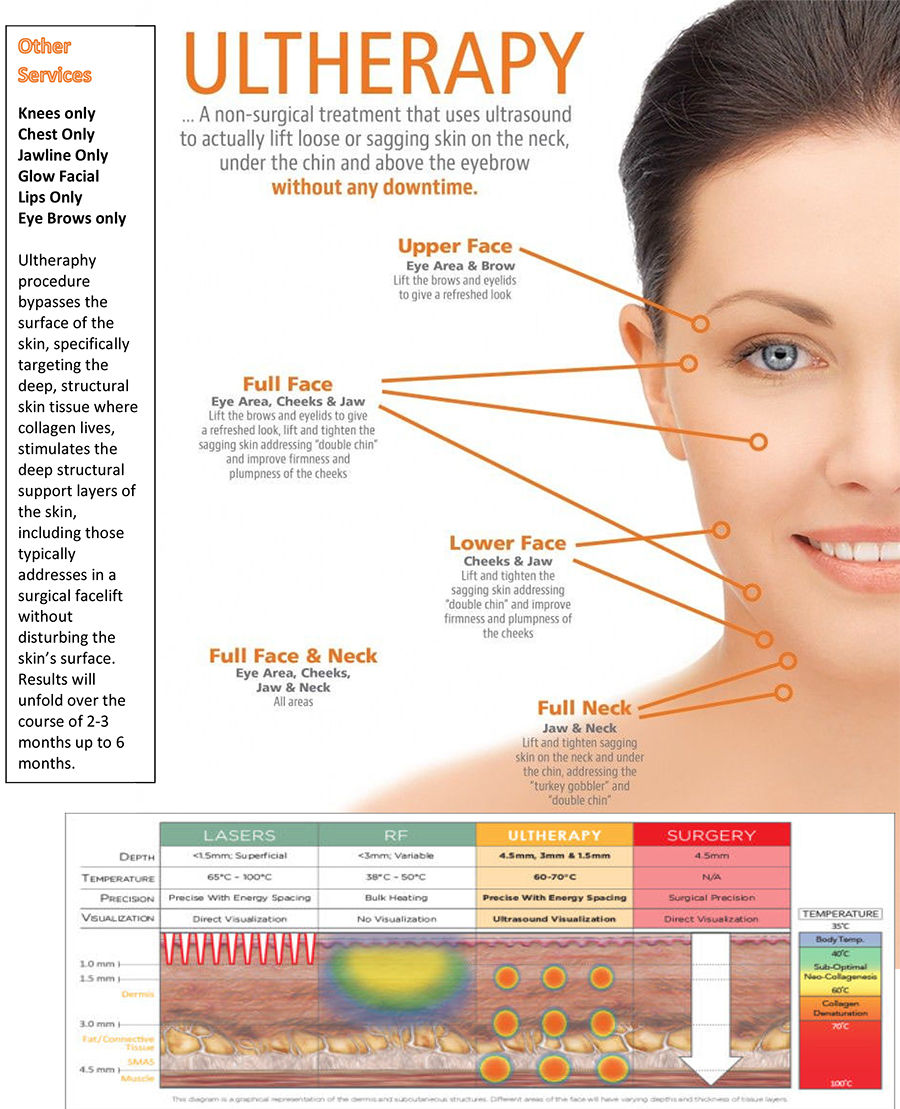Non surgical facelift Malaysia: FAQs
Wiki Article
The Additions of Ultherapy: What You Need to Know About This Non Surgical Lift Service
Ultherapy stands out as a preferred non-surgical lift alternative, leveraging ultrasound innovation to improve skin suppleness. This procedure not just targets various locations but additionally provides to a wide age array. People frequently seek it for its minimal downtime and instant advantages. Recognizing the intricacies of Ultherapy-- from treatment locations to candidacy-- is important for anybody contemplating this rejuvenation technique. What are the key elements to assess prior to continuing?What Is Ultherapy and Exactly How Does It Work?
Ultherapy is a non-invasive cosmetic treatment that uses ultrasound innovation to stimulate collagen production in the skin. Approved by the FDA, it targets the deeper layers of the skin, especially the fundamental layer usually addressed in cosmetic surgery. Throughout the procedure, a handheld gadget supplies focused ultrasound power to stimulate the skin, motivating a natural recovery reaction. This procedure motivates the manufacturing of new collagen, which aids to tighten and raise the skin in time.
The procedure is usually well-tolerated, calling for no incisions or downtime, making it an appealing alternative for those seeking facial rejuvenation without surgical procedure. The therapy can be customized to fit private demands, allowing professionals to resolve details areas of worry. Outcomes slowly appear over a few months as collagen builds, offering a refined yet visible improvement in skin appearance and suppleness. In general, Ultherapy stands for a modern technique to skin tightening and rejuvenation.
Secret Benefits of Finding Ultherapy
Countless individuals looking for non-surgical skin renewal find Ultherapy to be an eye-catching choice because of its selection of advantages. One of the main benefits of Ultherapy is its capacity to promote collagen manufacturing, leading to tighter and firmer skin gradually. This therapy uses ultrasound innovation, which enables specific targeting of much deeper skin layers without damaging the surface area.Furthermore, Ultherapy is a non-invasive treatment, indicating there is no need for surgical cuts or extensive recovery periods. Individuals can typically resume their everyday activities right away after treatment. The results of Ultherapy can be steady, offering a natural-looking lift that boosts the person's appearance without a sudden change.
Furthermore, Ultherapy appropriates for different skin types and can be tailored to satisfy individual needs. With its proven efficacy and safety, lots of people take into consideration Ultherapy an engaging alternative for achieving younger skin without the need for surgical treatment.
The Ultherapy Therapy Process
The Ultherapy therapy procedure includes a collection of well-defined steps developed to assure suitable outcomes. An examination allows the specialist to evaluate the person's requirements and figure out the appropriate therapy plan. During the treatment, the skin is washed, and an ultrasound gel is used to facilitate smooth application of the tool.The Ultherapy tool makes use of focused ultrasound energy to boost collagen production deep within the skin. As the ultrasound power is delivered, the individual may experience a feeling of heat or minor pain, which is normally well-tolerated. The duration of the therapy differs depending upon the location being attended to however usually lasts in between 30 to 90 mins.
Post-treatment, individuals can resume their everyday activities with very little downtime. Outcomes begin to gradually appear over the complying with weeks, as the body normally produces new collagen, enhancing skin suppleness and elasticity.
Areas of the Body That Can Be Dealt with

Various locations of the body can gain from Ultherapy treatment, making it a functional option for those looking for non-invasive skin tightening up. Primarily, the face is a prime focus, with Ultherapy effectively raising and tightening the skin around the brow, cheeks, and jawline. This therapy can likewise resolve sagging skin on the neck, using a renewed look.
In enhancement to face locations, Ultherapy is appropriate for the décolletage, where it helps boost skin structure and suppleness. The therapy can expand to other locations, such as the arms and abdomen, where loose skin might happen.
Expected Results and Recuperation Time
Anticipated outcomes from Ultherapy normally consist of a noticeable lifting and firm of the skin, with outcomes coming to be much more noticeable over time as collagen manufacturing boosts. Many people report noticeable enhancements within 2 to 3 months post-treatment, with suitable outcomes usually seen around 6 months. The non-invasive nature of Ultherapy adds to its allure, as it normally requires minimal downtime.Individuals may experience light swelling, soreness, or tenderness in the dealt with locations, however these adverse effects normally settle swiftly. The majority of people can resume their regular activities right away after the procedure.
While the long life of results differs, results can last up to a year or longer, depending upon individual skin problem and maturing processes. Regular follow-up sessions might help maintain the wanted outcomes, boosting the general effectiveness of the treatment.
Who Is an Excellent Prospect for Ultherapy?
Determining who is a good candidate for Ultherapy involves considering a number of elements. The suitable age array typically drops in between 30 and 65, while skin kind and any kind of underlying wellness problems likewise play essential functions in qualification. Recognizing these requirements can assist individuals assess whether Ultherapy is an appropriate option for them.
Perfect Age Array
Ultherapy is most reliable for people in their 30s to 60s who are starting Non surgical facelift Malaysia to notice indications of aging, such as drooping skin or loss of elasticity. This age variety commonly represents a transition phase where the skin's all-natural collagen production starts to decrease, making it an ideal time to assess non-surgical training choices. Candidates in their 30s might seek Ultherapy as a preventative step, while those in their 40s to 60s commonly seek to address much more pronounced indications of aging. Notably, Ultherapy is not restricted to a certain group; both males and females can benefit. Inevitably, the very best candidates are those that desire subtle lifting and tightening up without the demand for intrusive treatments.Skin Type Considerations
People considering Ultherapy needs to take their skin kind into account, as it plays a substantial function in therapy performance. Generally, those with skin that displays indications of aging, such as sagging or laxity, are prime prospects. Ultherapy is particularly beneficial for people with reasonable to tool complexion, as the ultrasound energy targets much deeper layers without harming the surface area. On the other hand, people with darker skin kinds may face a higher threat of coloring changes. Additionally, skin structure and flexibility are important aspects; those with even more resistant skin may see much better results. Inevitably, an assessment with a qualified service provider can help determine viability based on details skin features, making sure a customized approach for ideal end results.Wellness Issues Affecting Eligibility
Qualification for Ultherapy can be influenced by different health and wellness conditions that might influence the skin and overall wellness. Candidates with certain skin disorders, such as active acne, eczema, or psoriasis, may not appropriate, as these conditions can disrupt the therapy's effectiveness and safety and security. Furthermore, people with a history of current face surgical treatments or those that have gotten injectable fillers in the targeted locations may require to wait prior to going through Ultherapy. People with certain clinical problems, like autoimmune illness or severe chronic ailments, need to likewise speak with their healthcare company to establish their viability. Inevitably, a detailed pre-treatment assessment is vital to guarantee the very best end results and to identify any potential threats associated with the treatment.Expense and Factors To Consider for Ultherapy Treatment
Comprehending the expense of Ultherapy treatment is crucial for potential candidates. Prices can differ based on factors such as place and the level of treatment called for. Additionally, funding choices may be available to aid handle the cost.Therapy Prices Review
Expense is a significant variable when considering Ultherapy treatment, as rates can vary extensively depending upon several elements. Factors affecting the expense include the treatment location, the supplier's experience, and geographic location. Normally, sessions can range from $1,000 to $4,500, with larger areas or even more extensive therapies commanding higher charges. In addition, the number of sessions required for ideal results can affect total expenditures (Ultherapy Malaysia). It is crucial for potential individuals to seek advice from with accredited practitioners to receive tailored quotes based upon their one-of-a-kind demands. Transparency in rates is important, as surprise fees or add-ons might affect the total expense. Recognizing these variables can assist people make educated choices concerning their Ultherapy treatment optionsFinancing Options Available
While thinking about Ultherapy treatment, lots of potential patients explore financing alternatives to handle their expenses properly. Various clinics supply layaway plan that allow clients to spread out the price over numerous months, making the therapy extra easily accessible. Some facilities partner with third-party financing business, offering options such as low-interest loans and even interest-free durations. In enhancement, versatile investing accounts (FSAs) or health and wellness interest-bearing accounts (HSAs) might be used to cover expenses, depending on individual scenarios. Individuals are urged to make inquiries concerning feasible price cuts for in advance settlements or marketing offers that might be offered. Recognizing these funding choices can help potential patients make notified decisions concerning their Ultherapy therapy while reducing the financial burden related to this treatment.Frequently Asked Inquiries
For how long Do the Outcomes of Ultherapy Generally Last?
The duration of Ultherapy outcomes differs, usually lasting in between 6 months to 2 years (Skin tightening treatment KL). Elements influencing longevity include private skin type, aging process, and upkeep treatments, which can boost and extend the results of the procedure
Can Ultherapy Be Integrated With Other Therapies?
Ultherapy can without a doubt be incorporated with other treatments, such as fillers and neurotoxins. This combination technique commonly boosts total results, offering a much more comprehensive restoration effect while addressing various skin worries concurrently.Is Ultherapy Safe for All Skin Types?
Ultherapy is normally thought about risk-free for various skin types, however specific results may vary. Consulting a qualified professional is vital to figure out viability, as skin disease and level of sensitivity can affect therapy results and safety.What Are the Possible Adverse Effects of Ultherapy?
The prospective negative effects of Ultherapy may consist of temporary soreness, swelling, tenderness, or pain in treated locations. Some people may likewise experience minor discoloration or a prickling feeling, although these results commonly settle promptly.
The Number Of Ultherapy Sessions Are Generally Required for Optimum Outcomes?
Generally, individuals call for one to 3 Ultherapy sessions for ideal results. The precise number may differ based on skin disease and desired results, with lots of experiencing noticeable renovations after a solitary therapy. Routine evaluations might guide more sessions.Report this wiki page